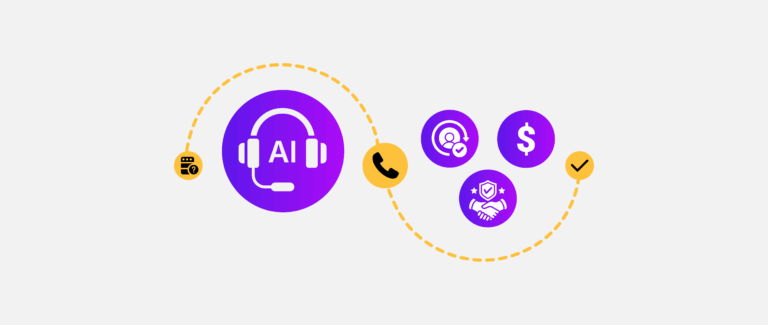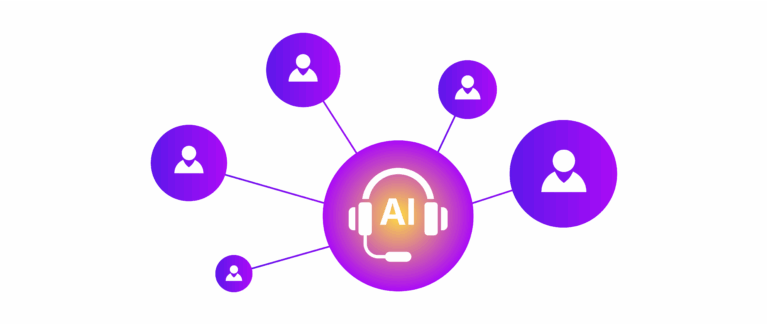AI is already changing how businesses work. However, for most, it remains working in the background as an assistant. You see it in forecasts, email suggestions, and automated support replies.
Helpful? Definitely. But mostly reactive.
However, there’s a transition happening. Across teams, AI is supporting communication and starting to own it. And not in a future-tense kind of way. It’s happening now.
Different types of AI are making it possible. For instance, predictive AI analyzes past behavior to guide decisions. Generative AI creates text, images, code, and more, based on massive language models like GPT. And then there’s conversational AI.
Conversational AI is built for interaction. It combines natural language processing (NLP), machine learning, and real-time decision logic to carry human-like conversations across chat, voice, and even video.
And it’s not just answering FAQs. It’s routing queries, qualifying leads, booking meetings, resolving tickets, and escalating complex issues when needed.
Because conversations still close deals. Support still needs a human tone. And buyers still expect relevance.
The only difference? Now, AI can deliver all that, on time, at scale, without burning out your team.
We will be discussing conversational AI in detail but first, let’s start with the basics.
What is conversational AI?
Conversational AI is exactly what it sounds like! It is AI designed to have conversations. But not just any conversations. Context-aware, real-time, goal-driven interactions that move things forward.
In its internal workings, it’s powered by a few key systems:
- Natural language processing (NLP) to understand what someone says (or types).
- Natural language generation (NLG) to compose responses that sound natural, not robotic.
- Machine learning to get smarter with every interaction.
If you assume this is a script with a menu of replies, you’re going in the wrong direction. Conversational AI can recognize intent, remember past inputs, personalize messaging, and handle branching logic. All of this in milliseconds!
Voice or text, web or mobile, inbound or outbound, it works wherever the conversation happens. Wherever your audience is, it can show up and speak their language.
It doesn’t need rules for everything. You don’t have to hardcode every response. It learns patterns. Adapts tone. Tracks outcomes. And over time, becomes a more natural part of your team.
That’s conversational AI. It is a system for engaging people. Intelligently.
How conversational AI works?
At a high level, conversational AI sounds simple: someone asks a question, and it gives a smart answer. But behind the scenes, there’s a layered system doing a lot more than just matching keywords to replies.
Here’s the breakdown for simpler understanding:
- Input processing
It starts with natural language understanding (NLU), which is a subfield of Natural Language Processing (NLP). This is where the AI breaks down what a person just said or typed. It analyzes the text to figure out intent (what the person wants) and entities (specific information like names, dates, product types, etc.).
For example:
“I want to upgrade my plan next month.”
Intent: Upgrade
Entity: Plan, next month
- Decision logic
Once the input is understood, the AI uses dialogue management to decide the next step. That could include pulling up an answer, asking a follow-up question, accessing external data, or escalating to a human. This is where it becomes dynamic.
Advanced systems, such as AI-driven platforms or assistants, use orchestration layers. These are logic flows that let the AI handle multi-step tasks. These flows can adapt mid-conversation based on what the user says, making the experience feel fluid instead of mechanical.
- Response generation
Now comes natural language generation (NLG). It is where the AI composes a response. It can pull patterns, knowledge, or phrasing from a pre-trained model, generate something from scratch, or combine both depending on the use case. The goal is to make the reply feel human, relevant, and context-aware.
- Learning loop
With every interaction, the AI collects feedback. It is either through explicit feedback (like thumbs up/down) or implicit feedback (like drop-offs, completion rates, escalations). It uses this data to improve. This is the machine learning layer, which helps it improve over time without being manually reprogrammed.
- Integration with tools
All of this only works if it connects to your ecosystem. Conversational AI typically plugs into your CRM, knowledge base, ticketing system, and analytics stack. That’s how it knows who it’s talking to, pulls real-time data, and updates records in the background.
The result? Conversations that aren’t just reactive. Instead, they become intelligent, personalized, and action-oriented.

Types of conversational AI agents
Not all conversational AI agents are built the same. Some handle simple queries. Others can carry multi-step conversations, remember the context, and drive outcomes. What they all have in common is the capability to hold conversations. And they’re getting better at it.
Here’s a quick look at the main types you’ll find in today’s workflows:
- Chatbots
These are the entry point for many businesses. They are placed on websites, apps, or messaging platforms to handle FAQs, guide users, or capture leads. The basic ones follow rules. The smarter ones are powered by AI. They can adapt in real time, understand intent, and personalize replies.
- Voice assistants
Alexa, Google Assistant, or in-app voice bots are a few examples. These systems process spoken language and respond instantly. They’re being used in homes, cars, and increasingly, customer support, as they reduce wait times and add a human-like layer to phone-based interactions.
- AI support agents
These are purpose-built to handle customer service. They route conversations, deliver relevant information, and step aside when human assistance is needed. These are built to work in close connection with support teams, handling more conversations without lowering the quality.
- Virtual sales assistants
Conversational AI is also qualifying leads, booking demos, and nudging deals forward. They can engage prospects across channels, respond to objections, and sync with your CRM. Always on, always consistent, and built to scale your outreach.
- Multimodal assistants
These are newer, more advanced. In addition to talking and typing, they combine voice, text, images, and even UI inputs. Imagine using a software dashboard while an AI talks you through it. It answers questions, highlights options, and guides you step by step. More than just about replying to input, it actively helps the user move through a task.
Benefits of conversational AI
Conversations move people. Every interaction is a chance to qualify a lead, remove friction, build trust, and guide someone toward conversion.
But the reality is that most teams don’t have the bandwidth to respond instantly, follow up consistently, or personalize every interaction.
That’s where conversational AI makes the difference.
Here’s how it helps revenue teams win:
- 24/7 lead engagement
AI agents engage leads instantly, around the clock. Whether someone fills out a form at 2 AM or clicks a campaign link on a weekend, the AI can start the conversation immediately, qualify interest, and book meetings without waiting for your team to catch up. And because it responds instantly, it keeps momentum high when interest is at its peak.
The result? Lower drop-offs and higher lead-to-meeting rates.
- Scalable personalization
One-size-fits-all doesn’t work anymore. AI agents connect directly to your CRM, MAP, and website analytics and measurement platforms. It references key data points like name, job title, company size, industry, campaign source, and browsing history without manual input.
That means it can adjust messaging based on the funnel stage, customize responses to specific pain points, and even prioritize high-value accounts automatically.
It leads to higher engagement and a better-qualified pipeline.
- Higher conversion rates
People don’t want to fill out long forms or wait for callbacks. They want quick answers and immediate action. AI agents transform static web pages, ads, and landing pages into interactive experiences that engage visitors instantly.
By providing real-time responses and guiding users through the next steps, it reduces drop-offs and keeps prospects moving forward.
Through this, enterprises can have more leads captured and higher conversion rates across their digital channels.
- Shorter sales cycles
By giving prospects what they need, when they need it, conversational AI removes unnecessary friction from the buying journey.
Instead of waiting for a follow-up email or filling forms, prospects can ask, get, and act in real-time.
AI can qualify interest within seconds, answer objections on the spot, and schedule meetings without delay.
And because it remembers the context of each interaction, it doesn’t reset the conversation every time someone returns. That means deals move faster. Fewer drop-offs. And sales teams spend more time closing, not chasing.
- Conversation-level insights
Every conversation generates valuable data. Conversational AI agents track user intent, common objections, drop-off points, and conversion paths, all in real-time. It captures which questions get asked most, which responses lead to engagement, and where prospects lose interest.
This insight directly informs your messaging, targeting, and campaign strategies. With this you get smarter outreach, better alignment across teams, and continuous optimization based on what’s working.
The closing loop
Conversational AI is changing how businesses talk to customers and turn interest into action. It makes conversations faster, smarter, and more personal. This is being done at a scale no human team could handle alone. And it doesn’t just answer questions; it drives real results by keeping prospects engaged, qualified, and moving forward.
If your team wants to win in today’s fast-paced market, conversational AI can be your pivotal advancement.
Lead the conversation or lose the lead. The choice is yours.





